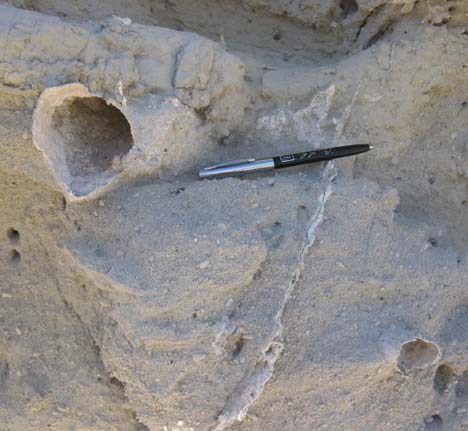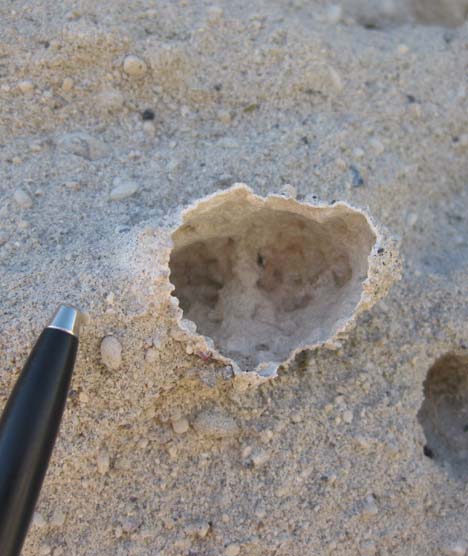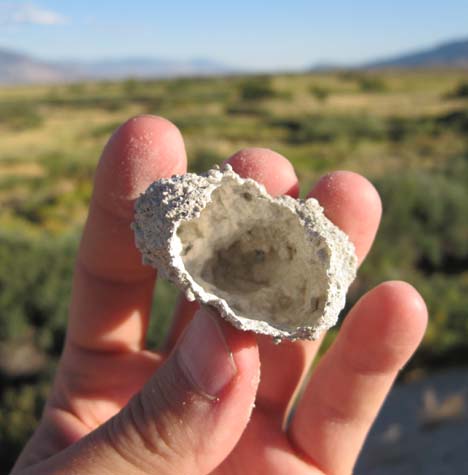So, I’ve introduced you to the sediments at the Crucifix Site, and the faults which cut across those sediments.
Today, I would like to show you something else that I found there, and ask you to tell me just what the hell it is.
Here we go: an outcrop of the volcaniclastic sediments in this area (stratigraphically beneath the Bishop Tuff), where you can find orb-like hollow structures in the weakly lithified rock. Here’s a couple:
Zoomed-in a bit on the biggest one:

I excavated it from the surrounding volcaniclastic sediments, and popped it out:

I have a guess what’s going on here, but I’m by no means certain. Any ideas from the peanut gallery about what this strange thing is?


It looks kind of like a lithophysal (devitrification) or vapor phase deposit inside a vesicle… but the surrounding rock doesn’t look like it was hot enough for either of those, nor can I really see how you’d get a vesicle of that size in what looks to be an airfall deposit. I’m a little stumped.
You know, it just occurred to me that it could be one of those burrows that has been around long enough to get a bit of secondary mineralization on its surface, like the mineralization on the fault plane in the first picture.
Good, good: anybody else? By the way, these are fluvial volcaniclastic deposits (ash and lapilli repositioned by stream water).
Well that wipes any possibility of the first two guesses.
Some creative guessing, as I have no clue about the region.
Pieces of ice (remember some of your own postings?) that got ripped along and then got dissolved.
Alternatively, we could use evaporitic pebbles.
I’m thinking trapped air or gas pockets that were trapped in the slurry of ash and lapilli during deposition?
Okay — I’m not sure how the original void space formed, but if you look at the obsidian pebble in the first post, you’ll note that a significant amount of devitrification has taken place since the sediments were deposited. It’s quite possible to me that a blob of pumice originally occupied these holes, and then that pumice (with its tremendous surface-area-to-volume ratio) devitrified, leaving a void space. That void space was then lined with mineral deposits, specifically “caliche” groundwater-deposited calcite, typical of arid regions. The same caliche sealed shut the small crack in the right of the first “WTFite” photo. What do you think?
Boy, I dunno… aren’t those little rounded clasts in the second photo also pumice? Why would larger clasts preferentially devitrify- completely, at that- and the smaller ones be unaffected. Caliche sounds right, but I’m dubious regarding your void space mechanism.
No, they’re not. They’re little obsidian grains, “formerly known as pebbles,” but now devitrified with a “chalky” exterior shell, presumably of palagonite or some such. I saw tons of pumice clasts in the overlying Bishop Tuff, but none at the Crucifix Site (which is older volcaniclastic sediments).
I’m open to the Lost Geologist’s idea about ice clasts, too, but the thing is: both pumice and ice float. Unless you’ve got some massive slurry (which the reasonably fine layering here precludes), you wouldn’t get floaties deposited with the rest of this sediment.
Yeah, I went back and looked at the obsidian clast in your first post, and was a little surprised at the degree/depth of devitrification. I wish I had a few other hypotheses to bounce around, but…
Not all pumice floats, and it can get waterlogged as well. Take a look in any creek bed around Crater Lake, especially in the flats outside the eastern boundary of the park. I think part of my hesitancy here is that there would some residuum from the devitrification, leaving a thicker bottom calcareous crust, and a thinner top crust. The caliche shell (BTW, did you acid or scratch test it?) looks fairly consistent in thickness from the photos.
I’m ruling out burrows here; you would expect them to be uniform in size, and the first photo shows they’re not. I was also thinking taffoni/cavernous weathering, with later cementation, then subsequent erosion of the face, but that seems a little contrived. This is a puzzler… which is fine; I like puzzles.
Hmmmm, forgot about the nice cross-bedding ruling out my slurry idea. Would it even be possible for small pockets of gas to form within the sediments of say a highly oxygenated fluvial environment? just curious. Devitrification didn’t even occur to me, but seems as valid as any theory, although it’s curious to me why there is such a large void space, whatever the cause/mechanism. My other thought harkened back to the first post with the bird & wasp burrows. If not birds or wasps, perhaps some other type of modern bioturbation? Any other known critters that would create a nesting area like that?
It’s a tricky little bugger, isn’t it? All I can say is “WTF?” 😉
Okay, probably last post about this, but its been rattlin’ around in my head all evening. Given the size of the void space on this one I’m liking the idea that it was a devitrified piece of pumice more and more. Also, I’m not sure what the paleoclimatic conditions at this location have been, but I’m wondering if alternating periods of drought/wet conditions would facilitate the process, or perhaps help explain the uniform thickness of the calcareous crust. I wonder if this phenomena is common in other volcaniclastic deposits?